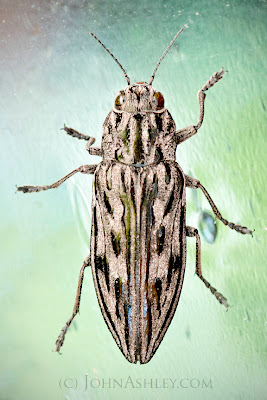 |
| Adult Western Sculptured Pine Borer |
 |
| The beetle's "sculptured" back |
Many of the wood-boring beetles engage trees in a form of complex chemical warfare. The adult beetles key in on scents produced by injured trees, and on the communication pheromones produced by other beetles. Some species attack en masse in order to overcome the tree's defensive measures.
Females are attracted to injured and drought-stricken trees, which emit a defensive compound (myrcene) when stressed. The tree bleeds sticky sap to "pitch out" the first few beetles that attack. But the females make a pre-emptive strike by releasing pheromones to attract additional male and female beetles to the tree.
Male beetles are drawn to the injured tree by the pheromonal message sent out by early-arriving females. Once they locate the tree, males release their own pheromone which attracts even more beetles to the front line. After mating, however, males and females both change their chemical signals. Now they release pheromones that interrupt further attraction by more beetles.
There are entire cohorts of native insects like these that are drawn to forests stressed by drought and scorched by fire. Before we started warming the global climate and putting out forest fires, these insects only affected forests on a small, localized scale. But we have unintentionally tipped the scales to favor these insects, and as a result we are now losing forests on a far larger scale.

